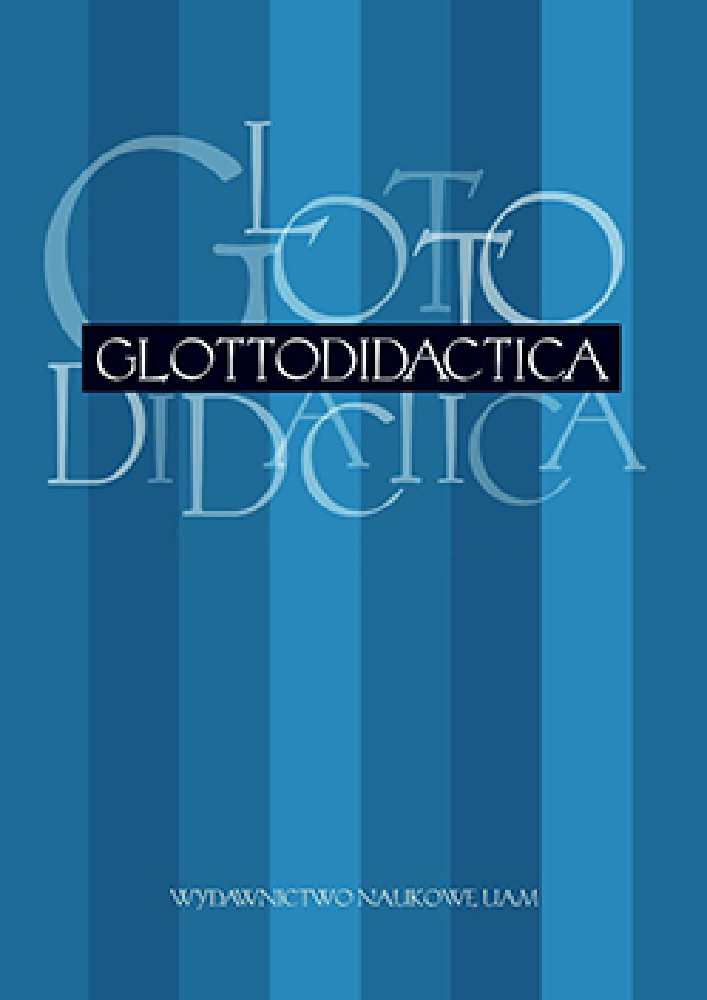Abstract
This article explores the problems which occur when teaching the translation of functional texts into a foreign language (from Polish into German). The article especially focuses on lexicalterminological and pragmatic translation mistakes, their causes, and strategies for avoiding them. One of the biggest challenges when translating into a foreign language is to use correct and adequate equivalents. The authors argue that the competences needed for this task should be taught as early as possible during translation training. The authors have therefore analysed texts translated by BA translation students and have chosen examples which represent the most frequent categories of mistakes, e.g. word-to-word translation, breaching the target language‘s conventions, and (inter)cultural problems. The solutions proposed are based on functional translation theory and translation criticism, and also take into account the classifications of mistakes used in translation didactics.
Literaturhinweise
Duden Online-Wörterbuch. http://www.duden.de [30.12.2017].
Hansen, G. (2006). Die Rolle der fremdsprachlichen Kompetenz. In: M. Snell-Hornby / H.G. Hönig / P. Kussmaul / P.A. Schmitt (Hrsg.). Handbuch Translation. Zweite, verbesserte Auflage. Tübingen: Stauffenburg, S. 341–343.
Hejwowski, K. (2009). Klasyfikacja błędów tłumaczeniowych – teoria i praktyka. In: A. Kopczyński / M. Kizeweter (Hrsg.). Jakość i ocena tłumaczenia. Warszawa: Wydawnictwo Szkoły Wyższej Psychologii Społecznej „Academia, S. 141–161.
Kozłowska Z. (2000). Nauczanie tłumaczenia pisemnego na język ojczysty a nauczanie tłumaczenia pisemnego na język obcy. In: A. Setkowicz (Hrsg.). O nauczaniu przekładu. Warszawa: TEPIS, S. 62–77.
Krings, H.P. (1986). Was in den Köpfen von Übersetzern vorgeht. Eine empirische Untersuchung zur Struktur des Übersetzungsprozesses an fortgeschrittenen Französischlernern. Tübingen: Narr.
Neunzig, W. / Tanqueiro, H. (2007). Risikominimierung beim Übersetzen in die Fremdsprache: ein Thesenpapier aus spanischer Sicht. In: G. Wotjak (Hrsg.). Quo vadis Translatologie? Berlin: Frank & Timme, S. 279–292.
Nord, Ch. (1988). Textanalyse und Übersetzen. Theoretische Grundlagen, Methode und didaktische Anwendung einer übersetzungsrelevanten Textanalyse. Heidelberg: Groos.
Nord, Ch. (1999). Transparenz der Korrektur. In: M. Snell-Hornby / H.G. Hönig / P. Kussmaul / P.A. Schmitt (Hrsg.). Handbuch Translation Zweite, verbesserte Auflage. Tübingen: Stauffenburg, S. 384–387.
Nord, Ch. (2009). Textanalyse und Übersetzen. Theoretische Grundlagen, Methode und didaktische Anwendung einer übersetzungsrelevanten Textanalyse, 4. überarbeitete Auflage. Tübingen: Groos.
Nord, Ch. (2010). Fertigkeit Übersetzen. Ein Kurs zum Übersetzenlehren und -lernen. 2. Auflage von Nord 2002. Schriftenreihe des BDÜ 38. Berlin: BDÜ Service Verlag.
Nycz, K. (2012). Aus Fehlern lernen – Neues aus dem Irrgarten translatorischer Fehlleistungen. In: Studia Niemcoznawcze, XLIX, S. 679–692.
Nycz, K., Tęcza Z. (2013). Übersetzungskritik an Übersetzungsleistungen: Analysen fehlerhafter Translate. In: K.-D. Baumann / H. Kalverkämper (Hrsg.). Theorie und Praxis des Dolmetschens und Übersetzens in fachlichen Kontexten. Berlin: Frank & Timme, S. 703–742.
PACTE (2003). Building a Translation Competence Modell. In: F. Alves (Hrsg.). Triangulating Translation: Perspectives in process oriented research. Amsterdam: John Benjamins, S. 43–66.
Pisarska, A. / Tomaszkiewicz, T. (1998). Współczesne tendencje przekładoznawcze. Poznań: Wydawnictwo Naukowe UAM.
Schmitt, P.A. (1997). Evaluierung von Fachübersetzungen. In: G. Wotjak / H. Schmidt (Hrsg.). Modelle der Translation. Festschrift für Albrecht Neubert. Leipziger Schriften zur Kultur-, Literatur-, Sprach- und Übersetzungswissenschaft. Frankfurt am Main: Vervuert, S. 301–332.
Słownik Języka Polskiego PWN. http://www.sjp.pwn.pl [2.01.2018].
Stolze, R. (1997). Bewertungskriterien für Übersetzungen – Praxis, Didaktik, Qualitätsmanagement. In: E. Fleischmann / W. Kutz / P.A. Schmitt (Hrsg.). Translationsdidaktik – Grundfragen der Übersetzungswissenschaft. Tübingen: Narr., S. 593–602.
Stolze, R. (1999). Die Fachübersetzung. Eine Einführung. Tübingen: Narr.
Tęcza, Z. (2010). Errare translatoris est? Übersetzerfehlern auf der Spur. In: Z. Wawrzyniak / P. Bąk / M. Sieradzka (Hrsg.). Texte und Translation. (=Danziger Beiträge zur Germanistik 29). Frankfurt am Main: Peter Lang, S. 281–296.
Wills, W. (1977). Übersetzungswissenschaft. Probleme und Methoden. Stuttgart: Klett.
Lizenz
Authors
Authors of texts accepted for publication in Glottodidactica are required to complete, sign and return to the editor's office the Agreement for granting a royalty-free license to works with a commitment to grant a CC sub-license.
Under the agreement, the authors of texts published in Glottodidactica grant the Adam Mickiewicz University in Poznań a non-exclusive, royalty-free license and authorize the use of Attribution-NoDerivatives 4.0 International (CC BY-ND 4.0) Creative Commons sub-license.
The authors retain the right to continue the free disposal of the work.
Users
Interested Internet users are entitled to use works published in Glottodidactica since 2016, under the following conditions:
- attribution - obligation to provide, together with the distributed work, information about the authorship, title, source (link to the original work, DOI) and the license itself.
- no derivatives - the work must be preserved in its original form, without the author's consent it is not possible to distribute the modified work, such as translations, publications, etc.
Copyrights are reserved for all texts published before 2016.
Miscellaneous
Adam Mickiewicz University in Poznań retains the right to magazines as a whole (layout, graphic form, title, cover design, logo etc.).





